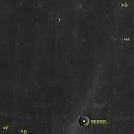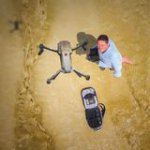
KnightsFan
-
Posts
1,214 -
Joined
-
Last visited
Reputation Activity
-
 KnightsFan got a reaction from Shield3 in EOS R official video specs discussion
KnightsFan got a reaction from Shield3 in EOS R official video specs discussion
Yeah, exposure is the same.
However, snip out a "crop" of the pic, and then blow that crop up to the size that the original was. Noise will be more apparent on the crop than on the original.
If you wanted the noise level to be equal on the crop as the original, you lower the ISO, and open the aperture to compensate.
-
 KnightsFan reacted to Shield3 in EOS R official video specs discussion
KnightsFan reacted to Shield3 in EOS R official video specs discussion
No one is saying the EXPOSURE is different. The same intensity of light is hitting the sensor. I am saying all things being equal, a larger sensor gathers more total light and has less read noise than a smaller one. Have you forgotten that the micro 4/3rds cameras struggle past ISO 1600? This isn't about crop or camera exposure, but equivalent DOF. You can't multiply the focal length without multiplying the effective aperture. This is why the Nokton F/0.95 25mm is roughly a 50mm F/2 in FF terms. Same rule is reversed when you go the other way. Instead of having the full 24x36 sensor "gather" light for your video, the Canon in this case, it's the (almost) S16 dead center of the sensor "gathering" light.
Andrew gets it - the 28-70 F2 when shooting UHD on the EOS R is roughly a 48-117mm F3.5.
-
 KnightsFan reacted to mnewxcv in NX1 and Davinci Resolve Issue
KnightsFan reacted to mnewxcv in NX1 and Davinci Resolve Issue
I've been debating picking up the e1 since they're really fair in price. I know it has its limitations, but compared to a go pro in situations that don't need a plastic enclosure or waterproofing, there seems to be a lot in its favor.
-
 KnightsFan got a reaction from mnewxcv in NX1 and Davinci Resolve Issue
KnightsFan got a reaction from mnewxcv in NX1 and Davinci Resolve Issue
The cameras aren't out yet, but I downloaded test clips from the Z cam website and the facebook group. The 4k 120 fps is absolutely stunning, honestly looks like better quality than the 4k out of the NX1: perhaps less sharpening, and significantly less noise reduction. Z-Log is actually really easy to grade. And the best part is it was only 170 Mbps! As much as the P4K footage looks phenomenal, for 1/10 the data rate and very similar output, the E2 looks like the only camera I'd consider as an upgrade to the NX1 so far.
-
 KnightsFan got a reaction from mnewxcv in NX1 and Davinci Resolve Issue
KnightsFan got a reaction from mnewxcv in NX1 and Davinci Resolve Issue
Ah, interesting, I didn't see this when I posted before. Good to know!
Also, incidentally, I was just playing with the H.265 clips from the Z Cam E2 and they worked flawlessly in Resolve Free on Windows 10. So it seems that the color cast issue is specifically from NX1 footage.
-
 KnightsFan reacted to Andrew Reid in Canon EOS R full frame mirrorless talk hots up
KnightsFan reacted to Andrew Reid in Canon EOS R full frame mirrorless talk hots up
I partly agree, but you buy an expensive full frame camera to shoot full frame don't you...
Pay the same money, and do it on the Z6.
Pay Canon and you get 1.75x crop.
It's not acceptable.
And I don't care about 10bit nearly as much as I care about the wide angle of my $2000 lens.
I agree.
But the EOS R is a $4000+ investment for most people, certainly not a 200D or a beginner to intermediate camera.
Probably $2000+ for the body and the same again for new lenses.
I have directly compared dedicated video cameras like the C300 and C500 (I own one) to my mirrorless cameras.
Even the Samsung NX1's 4K is better than the C300, more cinematic, less moire and aliasing, just as good colour.
https://www.eoshd.com/2015/02/samsung-nx1-vs-canon-c300/
Or you could get a Sony. I preferred the A7S II over the FS5. A7 III is even better.
Or a Nikon.
Or a Panasonic.
Or a Fuji.
Or an Olympus.
Or a Blackmagic.
If someone is in the market for a pro video camera then they wouldn't be evaluating the EOS R at all or any of the other full frame mirrorless cameras, so it's an unrelated argument anyway.
Most people do not actually choose a C300 for the best image.
They just don't realise you can add NDs, larger battery and a pro audio interface to a mirrorless camera And want to look "PRO".
I don't think the ALL-I 400Mbit 4K on the GH5 is "quite poor".
And the audience will notice the full frame look of a Sony A7 III before the notice codec subtleties.
The main issue is people can't fcking grade it!
I am curious what stuff you've watched from the camera and how well it was shot and graded.
-
 KnightsFan reacted to John Brawley in Blackmagic Pocket Cinema Camera 4K
KnightsFan reacted to John Brawley in Blackmagic Pocket Cinema Camera 4K
I like the pictures. A lot.
This camera will probably replace the micro cinema camera for me as it’s not much bigger and is much easier to work with.
I didn’t feel as strongly about the 4K production camera / Ursa because they were limited, principally by dynamic range.
I have a deep affection for the 4.6K sensor and have shot nearly daily withnit since before it was launched. I know it very well.
This pocket camera will integrate and sit very nicely alongside the 4.6K. It’s already a closer match than the micro for me without having really tested it in an A/B scenario.
I was a little worried about it having less DR Than the 4.6K but I think the other clips show some great examples of what this sensor can do. “Nature” was incredibly tricky material to shoot as anyone who’s been in that situation before would know and it was unfair to see it being derided.
Those that did so only reveal their own inadequate understanding of what those shots reveal.
I can think of a million other scenarios I would have rather done but these sequences were specifically produced to illuminate what the camera can do in specific situations.
What im almost more excited about is the unification that Gen 4 brings. As I mentioned earlier, it’s pretty much the same people at BMD that brought you the first camera working on this camera.
They’ve learned a lot (and so have I) and I think Gen 4 is really strong. I wish this and extended video would get rolled out wide already as I think half the issue I see with users of BMD products is a lack of knowledge in grading.
Now BMD do have perhaps the greatest colour correction tool on the market BUT they don’t make it easy to get to a great result without a little arcane knowledge.
Even I often run into issues when working by myself and I see extended video being a great step in addressing that shortcoming. There’s no point in talking about how great you can make images shot RAW if you don’t know how to do it and can’t easily or intuitively find a way to do so.
With regards to the 4k Pocket.
Its a genuine low light contender. I was really impressed at what a useable picture it produces with little lighting.
I’m laughing at those that said it’s overlit. I mean a 500w chimera dimmed to almost nothing so the background lighting would still show though the tinted hotel windows is very very low light, much lower levels than the idiots demanding I walk out on the street and light by sodium were demanding.
Again, I laugh when I see comments about how noisy ISO3200 is but I’m guessing those users aren’t aware how much image processing their cameras are doing at high ISOs. BMD allow you as the user to choose your poison. A very very underrated feature. And like colour correction it’s almost too powerful because users haven’t been instructed to change their expectations, nor how to add noise reduction or sharpening so they can season to taste.
The best testbfootage will be friends users so the sooner they ship the cameras the better. Hopefully Gen 4 means there will be less hysteria about its performance and a few will realise there’s no point comparing it to a GHx or a Sony and learn to get the most from what it is good at.
JB
-
 KnightsFan got a reaction from webrunner5 in Canon EOS R full frame mirrorless talk hots up
KnightsFan got a reaction from webrunner5 in Canon EOS R full frame mirrorless talk hots up
True! But at some point, even the low end specs are good enough, a point which we hit a year or two ago for me (and probably many others). Some people really need/want 4k60p, but I'm happy with good quality HD, so ergonomics and usability are a real deciding factor these days. I'm really looking forward to seeing what Canon does, and let's be honest, I'm just as excited to see what the A7S3 is like.
-
 KnightsFan got a reaction from iamoui in Canon EOS R full frame mirrorless talk hots up
KnightsFan got a reaction from iamoui in Canon EOS R full frame mirrorless talk hots up
That's a really cool idea! I wonder how hard it would be to sell to the general public, though? I think people would balk at the idea of carefully inserting a ~20mm long lens rear element into their camera every time you change lenses. But it would certainly be innovative and make Canon's mirrorless much more appealing for the vast swaths of people who own EF or EF-S glass. EF mount is so common I adapted all of my Nikon lenses to Canon just to put them on a NX-EF adapter! Makes it so much easier to quickly use them on borrowed or rented cameras.
On a more general note, while I'm excited to see what Canon has in store, I bet it will be another disappointment for me as my main hope is for H.265. The NX1's codec quality is all I need, and I don't want to double or triple my hard drive consumption for marginal returns on that front. Once the GH5 implemented it, I hoped the floodgates would open to H.265 in mainstream cameras, but we may have to wait a little while longer. Canon would have to pull off something truly spectacular for me to buy into it without H.265.
-
 KnightsFan reacted to John Brawley in Blackmagic Pocket Cinema Camera 4K
KnightsFan reacted to John Brawley in Blackmagic Pocket Cinema Camera 4K
I think we're just nostalgic.
When the Ursa Mini 4.6K first started shipping there were many many threads that were EXACTLY the same as some of the complaints on here.... Users complaining that the UM4.6K didn't have the same mojo / look / feel as the 4K sensor which at that point was in the Production camera, the Ursa and the Ursa mini 4K.
This is a new sensor.
It has the same chef's in the kitchen, working with new ingredients.
Spend some time with the images, look at the RAWS when they're available and learn to get the most from it. THEN come back and post about what you like or don't like. But grading from a downloaded 264 and then writing it off as being inferior is a bit premature and simplistic.
JB
-
 KnightsFan got a reaction from Emanuel in Blackmagic Pocket Cinema Camera 4K
KnightsFan got a reaction from Emanuel in Blackmagic Pocket Cinema Camera 4K
Wait, hang on--are we seriously comparing footage uploaded to YouTube? Doesn't comparing compressed sRGB files sort of defeat the purpose of having higher data rates and dynamic range? I think we should wait for files straight out of the camera before making any real judgments.
-
 KnightsFan got a reaction from TheRenaissanceMan in Nikon Z6 features 4K N-LOG, 10bit HDMI output and 120fps 1080p
KnightsFan got a reaction from TheRenaissanceMan in Nikon Z6 features 4K N-LOG, 10bit HDMI output and 120fps 1080p
Yes and no.
"Color science" refers to the hardware and software that the manufacturer uses to define the output of their camera. For example, Arri's color science may include a dual gain architecture in order to make the highlights behave a certain way, whereas Sigma's Foveon color science involves a very specific type of sensor. The method of creating an image is certainly a science (specifically computer science) built out of objectively measurable variables. The subjective part is that one person may prefer the end result of a specific color science over another, and so a preference of one color science vs. another is not a science itself.
And my argument is that having a preference about the subjective part is a perfectly valid way to decide which camera to get, especially now that almost every modern camera has high technical quality.
-
 KnightsFan reacted to Charbax in Nikon Z6 features 4K N-LOG, 10bit HDMI output and 120fps 1080p
KnightsFan reacted to Charbax in Nikon Z6 features 4K N-LOG, 10bit HDMI output and 120fps 1080p
Only one XQD card slot? But that's not acceptable for any serious pro, is it? Only one slot means some Z6/Z7 owners most definitely will lose everything, which is unacceptable if you're doing a paid job. Dual card slots is a requirement!
The lack of flippy display means the device is quite unusable for people creating content themselves without a dedicated cameraman at all times to check the framing, focus and etc. Filming yourself or conducting interviews is hopeless unless you add a bulky external display. What a shame.
Does it have a 30min video record limit? I certainly hope not!
And I want 4K 60p so I am not buying Z6, sorry.
I wish these new high performance encoders had H265 codec as an option too to be able to record to a lower bitrate keeping the same quality, easier for YouTube 4K uploading for people (like me) who don't need/want to do post production rendering and the like.
-
 KnightsFan got a reaction from kaylee in Rotoscoping 911 – HELP!!
KnightsFan got a reaction from kaylee in Rotoscoping 911 – HELP!!
So you are removing people from the background of a static shot?
Can you take a single frame, paint out the people in Photoshop (or photo editor of your choice) and then simply composite the edited part of the photoshopped image over the entire video?
-
 KnightsFan got a reaction from buggz in Panasonic GH5 10 bit internal recording not good enough
KnightsFan got a reaction from buggz in Panasonic GH5 10 bit internal recording not good enough
Nice analysis. I'm glad you actually delve into the numbers and explain the different types of encoding!
However, it would be better if you included files straight out of camera and ran analysis on them, both qualitative and quantitative. Since Prores and AVC intra use different algorithms, simply comparing data rates is not an accurate representation of their fidelity. I suggest encoding an uncompressed video into Prores, and also into AVC intra, and then running a script to compare the compressed images to the original and get an exact number on how much scene data is lost.
Also, your title is meaningless unless you specify what the 10 bit internal is not good enough for. Is the 10 bit theoretically as good as Prores? Maybe--let's run some tests and see. Is the GH5's specific implementation inferior to external recording to Prores HQ? We need real world tests again. Are the GH5's 10 bit codecs better than any other photo/video hybrid's codecs? Almost certainly. Is it good enough for anything that we used to use GH3 and GH4's for? Of course!
-
 KnightsFan got a reaction from hansel in Liliput A5, or any other cheap 5" or smaller competitors?
KnightsFan got a reaction from hansel in Liliput A5, or any other cheap 5" or smaller competitors?
I got the A5 in a rush (after finding last minute that the Ninja 2 does not work with the NX1), and have been shooting with it every day for the past two weeks. I'm pretty happy with it. Regarding the discussion of the brightness, it's adequate. I've had the brightness at 50% and it's viewable outside for framing and peaking, though it's no match for an EVF. All in all I would totally recommend it to anyone on a budget who doesn't want a massive 7" monitor. But make sure your batteries work before using! Here are my pros and cons, loosely in comparison with the Feelworld FW760 that I used to use.
+ Smaller but still 1080p. 5" vs 7" is a huge difference - and also it has thinner bezels and is thinner so it's actually much much smaller.
+ MUCH lighter. Makes my setup more balanced
+ HDMI out
+ Mounting points on three sides
+ Screen is fantastic. Focus peaking works very well.
+ It remembers settings through power on/off cycles. The FW760 would reset everything if it powered down.
- The battery plate is finicky. It's not a problem for me since I power everything from a power bank (I didn't even own any batteries for my FW760). It will not work with a Wasabi LPE6, but it will work with an Ipax LP-E6, even though BOTH of those batteries power a 5D3 perfectly.
- Plasticky. I think the FW760 felt a little sturdier, but not by much. However, the mounting points seem secure and it's not going to fall apart in your hands. Sort of the build you expect from a screen this price.
- Only one customizable button.
- False color does not have a color scale on the side, so you have to guess what IRE each color corresponds to
- The 1/4-20 threads are too shallow. I had to put a few washers on my friction arm's thread.
- The hot shoe mount that comes with it is junk.
- It would have been really nice to put one of these on the back: https://www.amazon.com/SmallRig-Camera-Threaded-Monitor-Accessories/dp/B01NCK79G2 . I had one on my FW760 and then used a lock washer on the friction arm to keep it from accidentally rotating.
-
 KnightsFan reacted to anton.zimin@gmail.com in ISCO Ultra Star Red - electronic single focus solution.
KnightsFan reacted to anton.zimin@gmail.com in ISCO Ultra Star Red - electronic single focus solution.
Hello! I'd like to share with you my setup.
It is very simple to do, nevertheless I've spent about a $1000 to try different ways and ideas. I end up with a setup which costs about $200-300. It is a fully electronic dual follow focus system, controlled by Arduino Nano with two servos and powered by 2 3.7 Li-ion 4800 mAh batteries. The price very much depends on motors and potentiometers you choose. You can calibrate it with any lens.
Still it is a bit noisy and I'd like to make a wireless version as well plus add a monitor and a possibility to store more than one lens in its memory.
VIDEO
-
 KnightsFan got a reaction from kaylee in Resolve to After Effects
KnightsFan got a reaction from kaylee in Resolve to After Effects
I would not use dynamic linking (or whatever it's called with Resolve/Fusion) if you can avoid it. Just bring the original clip into the compositor of your choice, do the effects, and render out a new clip. Then replace the clip in Resolve. The key is to be organized, so you can easily remember which effects clips replace which raw clips.
You'll have no performance hit, fewer chances of crashing, and more control over what gets rendered when, and it will make no difference whether you use Fusion, AE, both, or something else entirely. No point forcing yourself to use a specific tool just because it's the same brand as your editor!
I do recommend learning Fusion at some point if you have a lot more VFX shots in the future. Fusion is much easier to composite with, AE is better for motion graphics animation.
-
 KnightsFan got a reaction from kaylee in Resolve to After Effects
KnightsFan got a reaction from kaylee in Resolve to After Effects
1. Personally, I would composite first, and grade afterwards. However, I don't see any reason you can't do it the other way around if that workflow is easier for you. The benefit of compositing first is that you composite on the original footage, and render that once before the final export. Going the other way, you transcode, then composite, then render, then do the final export. It takes more time, and arguably reduces quality.
2. You want the highest quality possible without breaking your hard drive. I always render effects as lossless image sequences, either PNG or TIFF. If you want high bit depth, 16 bit TIFF is the way to go, since PNG is 8 bit except in rare circumstances. The benefit of an image sequence is that you can re-render specific sections without re-rendering the entire thing, which, depending on the effects, could save you a LOT of time. Again, if you composite first, you're only rendering out the effects once instead of twice, which saves a lot of HDD space.
3. Depending on your effects and how much you care about image fidelity, you might be able to simply render the effects from AE, and composite them in Resolve. That's what I do whenever possible. It saves rendering time and means no transcoding of any kind before rendering.
-
 KnightsFan got a reaction from maxmizer in Final Cut ProRes RAW
KnightsFan got a reaction from maxmizer in Final Cut ProRes RAW
It's not RAW the way photo cameras use the term: lossless linear camera data. It's the same story with Redcode Raw, Canon RawLite, and Blackmagic's compressed Raw. They realized that compressing before debayering allows them to pack more meaningful data in smaller files, with the caveat that the user is required to debayer the files later. And, naturally, they call it raw because they want people to confuse it with actual RAW camera data.
-
 KnightsFan got a reaction from Robert Collins in Final Cut ProRes RAW
KnightsFan got a reaction from Robert Collins in Final Cut ProRes RAW
It's not RAW the way photo cameras use the term: lossless linear camera data. It's the same story with Redcode Raw, Canon RawLite, and Blackmagic's compressed Raw. They realized that compressing before debayering allows them to pack more meaningful data in smaller files, with the caveat that the user is required to debayer the files later. And, naturally, they call it raw because they want people to confuse it with actual RAW camera data.
-
 KnightsFan reacted to BTM_Pix in looking for monitor opinions
KnightsFan reacted to BTM_Pix in looking for monitor opinions
My eyes are watering just imagining what such a contraption would do.
Auto correct obviously decided you wanted to literally have a balls up situation instead of avoiding a balls up of the audio variety.
-
 KnightsFan got a reaction from IronFilm in looking for monitor opinions
KnightsFan got a reaction from IronFilm in looking for monitor opinions
I, too, switched from 7" to 5" because the large screen was unwieldy. However, the size was not an issue for locked off tripod shots. It was just a problem for handheld or those occasional really tight spaces. I could see 7" being perfect for a one man show, where I assume you'll be using a tripod most of the time. However, if you ever do another project with a crew or handheld shots, I think the 5" will be more useful.
Either way, what about using a long HDMI cable and bringing the monitor with you, rather than leaving it on the camera? You can just set it down out of frame when you're ready to roll.
-
 KnightsFan got a reaction from Timotheus in Liliput A5, or any other cheap 5" or smaller competitors?
KnightsFan got a reaction from Timotheus in Liliput A5, or any other cheap 5" or smaller competitors?
@Timotheus No, it does not have anamorphic mode.
-
 KnightsFan got a reaction from Juank in Liliput A5, or any other cheap 5" or smaller competitors?
KnightsFan got a reaction from Juank in Liliput A5, or any other cheap 5" or smaller competitors?
I got the A5 in a rush (after finding last minute that the Ninja 2 does not work with the NX1), and have been shooting with it every day for the past two weeks. I'm pretty happy with it. Regarding the discussion of the brightness, it's adequate. I've had the brightness at 50% and it's viewable outside for framing and peaking, though it's no match for an EVF. All in all I would totally recommend it to anyone on a budget who doesn't want a massive 7" monitor. But make sure your batteries work before using! Here are my pros and cons, loosely in comparison with the Feelworld FW760 that I used to use.
+ Smaller but still 1080p. 5" vs 7" is a huge difference - and also it has thinner bezels and is thinner so it's actually much much smaller.
+ MUCH lighter. Makes my setup more balanced
+ HDMI out
+ Mounting points on three sides
+ Screen is fantastic. Focus peaking works very well.
+ It remembers settings through power on/off cycles. The FW760 would reset everything if it powered down.
- The battery plate is finicky. It's not a problem for me since I power everything from a power bank (I didn't even own any batteries for my FW760). It will not work with a Wasabi LPE6, but it will work with an Ipax LP-E6, even though BOTH of those batteries power a 5D3 perfectly.
- Plasticky. I think the FW760 felt a little sturdier, but not by much. However, the mounting points seem secure and it's not going to fall apart in your hands. Sort of the build you expect from a screen this price.
- Only one customizable button.
- False color does not have a color scale on the side, so you have to guess what IRE each color corresponds to
- The 1/4-20 threads are too shallow. I had to put a few washers on my friction arm's thread.
- The hot shoe mount that comes with it is junk.
- It would have been really nice to put one of these on the back: https://www.amazon.com/SmallRig-Camera-Threaded-Monitor-Accessories/dp/B01NCK79G2 . I had one on my FW760 and then used a lock washer on the friction arm to keep it from accidentally rotating.











